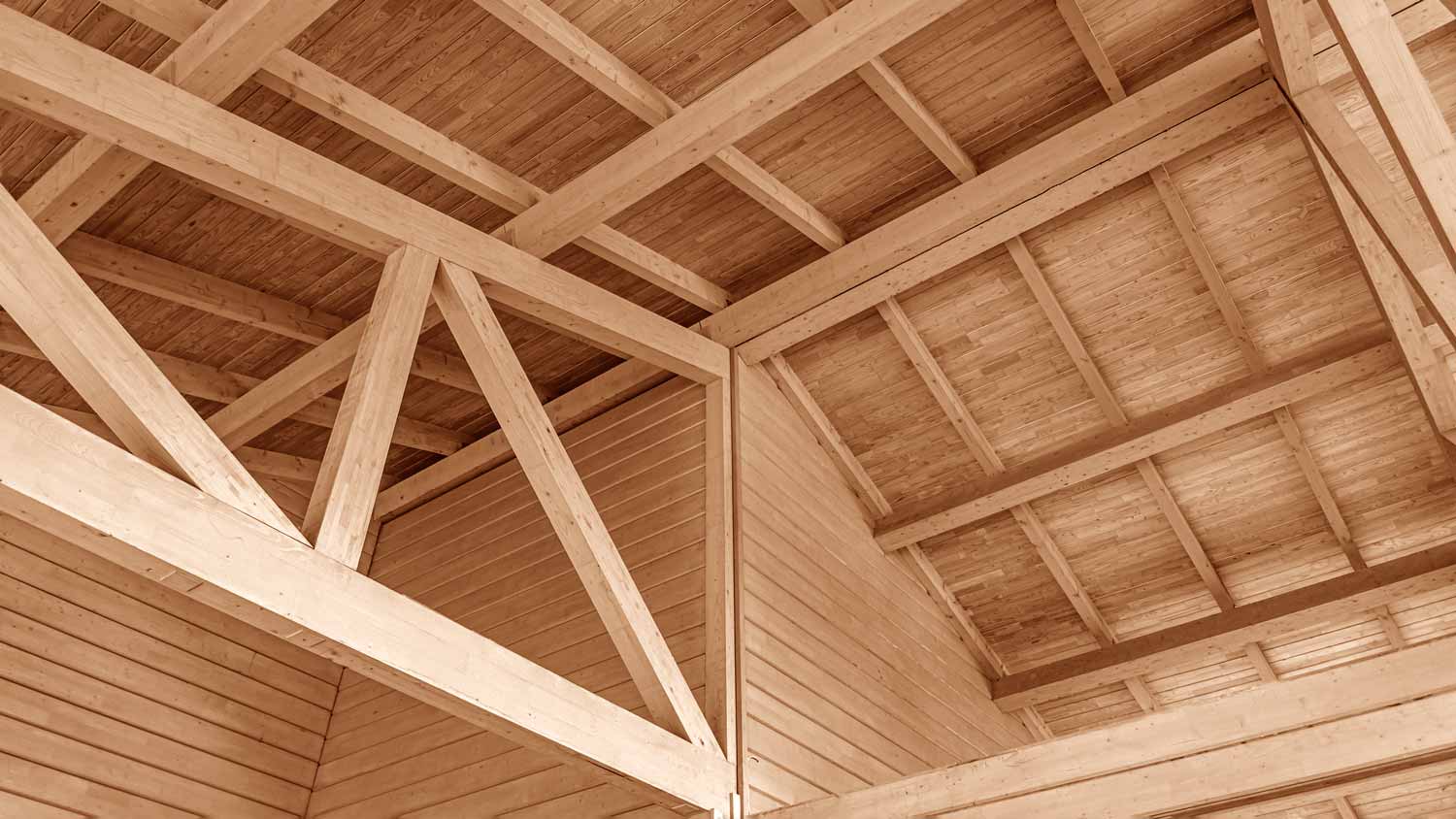
A new steel I-beam is more durable than a wooden one. Learn what factors can affect steel I-beam installation costs and how to budget for this project.
Don’t let incorrect spacing drag your ceiling down


In most homes, ceiling joists are spaced 16 or 24 inches on center.
If your ceiling must support a heavier load, you can space joists 12 inches apart.
Spacing joists 19.2 inches apart can save on project costs.
The type of joists, room size, and load requirements determine the spacing.
If you’ve ever tried to hang a light fixture, you’re probably familiar with the ceiling joists. These joists, which hide under your drywall, help support the weight of your ceiling and anything attached to it. Building code (along with a few other factors) dictates how far apart you must space your joists, and an improper installation can cause sagging and other structural issues. Luckily, your ceiling won’t buckle under pressure if you have the correct ceiling joist spacing.
When taking on this project, expect questions only a pro can answer. With our network of local pros, you'll get the job done and your questions answered—without the hassle and stress of doing it yourself.

In most homes in America, ceiling joists are spaced 16 or 24 inches on center. To get an on center measurement, you’ll measure from the center of one joist to the center of the other joist (as opposed to measuring from edge to edge). This is considered the standard spacing, though the exact spacing depends on a number of different factors—from your local building code to the weight the joists need to support. Here are some of the most common scenarios:
Standard room: For the standard 10-by-15-foot or 10-by-17-foot room, your contractor will use ceiling joists made from two-by-six pieces of lumber spaced 16 inches apart. This is enough to hold up 5-by-8-foot drywall, one of the most common materials used to finish ceilings.
Large room: If your room is 16 to 20 feet wide, you might need a larger joist. In this case, your contractor will probably use 2-by-10-foot joists spaced 24 inches apart.
Extra large room: If your room is more than 20 feet wide, you may need to space your joists closer together. Your contractor will use 2-by-10-foot joists spaced 12 inches apart.
Other scenarios: In some instances, your contractor will space your joists 19.2 inches on center. This is considered a middle ground between the standard 16-inch and 24-inch spacing and may be used in areas with lighter load requirements or when using engineered joists.
Though most residential construction falls within the norm, ceiling joist spacing is not a one-size-fits-all solution. Joists are an important structural element of your home, and only a licensed contractor or structural engineer can tell you the appropriate spacing. Consult a local ceiling company, and never install your own ceiling joists.

Most ceiling joists are made from standard lumber, but that’s not the only type. In commercial construction, it’s common to find a range of joists, from the ever-popular I-joists (made out of engineered wood) to steel or composite joists. The ideal spacing varies by type.
| Type of Joist | Spacing Range (Inches) | Typical Spacing (Inches) |
|---|---|---|
| Solid wood | 12–24 | 16, 24 |
| Engineered wood (I-joists) | 12–24 | 16, 19.2, 24 |
| Steel | 12–24 | 12, 16, 19.2, 24 |
Contractors will space wood ceiling joists 16 or 24 inches on center. Less commonly, you’ll find them spaced 12 inches on center (if you use two-by-four joists or need to support a heavy load) or 19.2 inches on center (this is more common for harder woods and areas with lighter load requirements).
Solid wood is the standard for residential construction. The most common types are #2 grade southern pine, Douglas fir, and hemlock fir. The type of wood and the grade will also determine the spacing.
Engineered wood joists (also known as I-joists) are spaced 16 or 24 inches apart—just like solid wood. You’ll also find them spaced 19.2 inches on center. Since I-joists are stronger than natural wood, contractors can cut project costs by increasing the spacing and reducing the number of joists used. They’re also lightweight, which makes them easier to install.
Steel joists, or metal studs or C-joists, are commonly spaced at 12, 16, 19.2, or 24 inches on center. The spacing depends on the exact application and the grade of the steel.
You usually won’t find steel joists in residential construction. Occasionally, a ceiling contractor will fix a sagging ceiling with this type of joist. More likely, you’ll find steel joists in commercial buildings, particularly when a ceiling must support additional stories, heavy HVAC equipment, or industrial storage.

As a structural element, ceiling joists must support a certain amount of weight. It’s more than just the drywall or a light fixture you might hang. For this reason, determining the right spacing involves several different factors.
The ceiling joist span is the distance between the supports holding the ceiling joist. The support is most likely a wall, but you can also use beams to support joists. This distance impacts how much weight a joist can support. For longer distances, you might need to space your joists closer together.
The International Code Council (ICC) sets spacing requirements based on the ceiling joist span and whether or not the joist is braced. Bracing, a technique used to reinforce ceiling joists, can help you space longer joists further apart.
Room size has a direct impact on ceiling joist spacing because it affects the ceiling joist span. Ideally, your joist should span across the entire room, from one wall to the opposite wall. This makes for the strongest construction.
In smaller rooms, you can space your joists 16 inches apart. In larger rooms and open plan spaces, you might need closer spacing (as little as 12 inches apart) to prevent sagging and other structural problems.
The size of the joist works in conjunction with the joist span to help you determine the ideal spacing. Lumber comes in standardized sizes. Even if you use engineered wood, joists are dimensions are:
Two-by-six feet
Two-by-eight feet
Two-by-ten feet
Two-by-twelve feet
Most homes use two-by-six-foot joists spaced 16 inches on center, but you might be able to use a two-by-ten-foot or two-by-twelve-foot joist in a large room. Depending on the size of the room, you can space larger joists further apart (up to 24 inches on center).
The material impacts your joist’s ability to hold weight. Most homes in the U.S. use joists made from softwood, but even different species of softwood are stronger than others. For example, Douglas fir-larch (DFL) lumber is slightly stronger than hemlock fir. You can space harder woods further apart or make them into larger joists. The same goes for stronger materials like engineered wood.
Lumber is graded, ranging from #3 (the lowest grade) to select structural (the highest grade). The higher the grade, the stronger the wood. This can impact the spacing of your joists, but it depends on the species of wood. Most homes use #2 grade joists, but you’ll be able to use longer pieces of higher grades and maintain the same spacing.
I-joists are also graded, but rather than a numerical grade, they’re graded based on performance.
Joists that support a heavy load must be spaced closer together. There are two types of loads that building codes consider when setting spacing regulations:
Dead load: The dead load is the permanent weight of the structure, like the weight of roofing materials, fixtures, flooring, or any other permanent part of your home that the joists must support.
Live load: This load is the temporary load your joists must support. This includes the weight of people, furniture, appliances, wind, and snow.
Even something as seemingly minor as remodeling your bathroom with marble flooring can increase the load requirement of the ceiling joists beneath it.
Certain ceiling designs require additional considerations when spacing your joists. For example, for a tray ceiling, you’ll need to run your ceiling joists across the shorter dimension of the room (as opposed to the longest dimension of the room). Open concept spaces can require longer beams that you’ll have to space closer together. It all depends on your specific space.
The 2021 ICC Code has set standards for spacing based on the size, wood species, and grade of the joist—but this is only a guide. You need to take additional factors into account, from where the ceiling is in your home to the finishes and fixtures. You’ll also need to consult local building code (though the ICC is at the global forefront of safety standards, your local building code may differ).
All in all, understanding ceiling joist spacing requires in-depth knowledge about construction. It isn’t a suitable DIY, and a sagging or collapsed ceiling is never a good time and can pose a safety issue. Always consult a structural engineer near you before making changes to structural elements in your home and hire a licensed contractor to get the job done.
From average costs to expert advice, get all the answers you need to get your job done.

A new steel I-beam is more durable than a wooden one. Learn what factors can affect steel I-beam installation costs and how to budget for this project.

Looking to expand your ceiling and send claustrophobia running for the hills? This guide covers the cost to vault a ceiling and factors that impact estimates.

The cost of a structural engineer is easily justifiable given the value they bring to the table. Use this guide to see what hiring your professional will total in Tampa, FL.

Do you have an upcoming construction project and aren’t sure whether hiring a structural engineer vs an architect is better? Find out here.

Do you have a load-bearing wall standing between you and your projects that you want to remove? Learn about the cost of removing a load-bearing wall.

A home doesn’t collapse unexpectedly. Learn the warning signs that a house will collapse, so you can protect your family and your home.